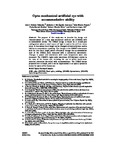Opto-mechanical artificial eye with accommodative ability
| dc.contributor.author | Esteve-Taboada, JJ | |
| dc.contributor.author | Del Águila-Carrasco, AJ | |
| dc.contributor.author | Marín-Franch, I | |
| dc.contributor.author | Bernal-Molina, P | |
| dc.contributor.author | Montés-Micó, R | |
| dc.contributor.author | López-Gil, N | |
| dc.date.accessioned | 2018-09-20T17:49:20Z | |
| dc.date.available | 2018-09-20T17:49:20Z | |
| dc.date.issued | 2015-07-27 | |
| dc.identifier.issn | 1094-4087 | |
| dc.identifier.issn | 1094-4087 | |
| dc.identifier.uri | http://hdl.handle.net/10026.1/12401 | |
| dc.description.abstract |
The purpose of this study was to describe the design and characterization of a new opto-mechanical artificial eye (OMAE) with accommodative ability. The OMAE design is based on a second-pass configuration where a small source of light is used at the artificial retina plane. A lens whose focal length can be changed electronically was used to add the accommodation capability. The changes in the OMAE's aberrations with the lens focal length, which effectively changes the accommodative state of the OMAE, were measured with a commercial aberrometer. Changes in power and aberrations with room temperature were also measured. The OMAE's higher-order aberrations (HOAs) were similar to the ones of the human eye, including the rate at which fourth-order spherical aberration decreased with accommodation. The OMAE design proposed here is simple, and it can be implemented in an optical system to mimic the optics of the human eye. | |
| dc.format.extent | 19396-19396 | |
| dc.format.medium | ||
| dc.language | en | |
| dc.language.iso | eng | |
| dc.publisher | The Optical Society | |
| dc.subject | Eye Disease and Disorders of Vision | |
| dc.subject | Bioengineering | |
| dc.title | Opto-mechanical artificial eye with accommodative ability | |
| dc.type | journal-article | |
| dc.type | Journal Article | |
| plymouth.author-url | https://www.webofscience.com/api/gateway?GWVersion=2&SrcApp=PARTNER_APP&SrcAuth=LinksAMR&KeyUT=WOS:000361035300079&DestLinkType=FullRecord&DestApp=ALL_WOS&UsrCustomerID=11bb513d99f797142bcfeffcc58ea008 | |
| plymouth.issue | 15 | |
| plymouth.volume | 23 | |
| plymouth.publication-status | Published | |
| plymouth.journal | Optics Express | |
| dc.identifier.doi | 10.1364/oe.23.019396 | |
| plymouth.organisational-group | /Plymouth | |
| plymouth.organisational-group | /Plymouth/Faculty of Health | |
| plymouth.organisational-group | /Plymouth/Faculty of Health/School of Health Professions | |
| plymouth.organisational-group | /Plymouth/REF 2021 Researchers by UoA | |
| plymouth.organisational-group | /Plymouth/REF 2021 Researchers by UoA/UoA03 Allied Health Professions, Dentistry, Nursing and Pharmacy | |
| plymouth.organisational-group | /Plymouth/Users by role | |
| plymouth.organisational-group | /Plymouth/Users by role/Academics | |
| dc.publisher.place | United States | |
| dc.identifier.eissn | 1094-4087 | |
| dc.rights.embargoperiod | Not known | |
| rioxxterms.versionofrecord | 10.1364/oe.23.019396 | |
| rioxxterms.licenseref.uri | http://www.rioxx.net/licenses/all-rights-reserved | |
| rioxxterms.type | Journal Article/Review |


